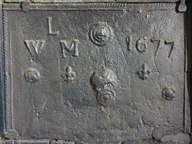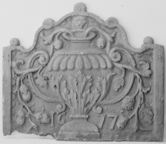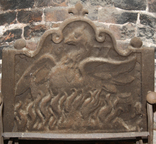-
306
Description: Rectangular; twisted rope edging (top and sides) with a fillet inside; top centre, concentric roundel with rose-and-crown below; top left, initials in triad with small rose below 'W' and small fleur-de-lys below 'M'; upper right, date with small fleur below '6' and small rose lower, below second '7'.
Notes: The style of rose and crown is similar to that used in gun founding in the Tudor period, suggesting that the furnace that was the source of this fireback may have been used for that purpose.
Inscription: WLM [triad] 1677
- Decoration tags:
- rectangular (shape)
- rope (edging)
- carved stamps
- individual letters
- individual numbers
- heraldic
- text
- objects
Manufactured: in 1677 in the Weald area of England.
Current location: in private hands, Speldhurst, Kent, England.
- Attached to series:
- 1660s-90s Wealden series
- Date & initials firebacks
-
866
Description: Rectangular with a sinuous arch and three simulated loops, one top centre, the other two to each side; two-handled flower vase with gadrooned upper surface and acanthus bas-relief below, trailing fruited vines issuing from top descending through handles to base; lion’s mask at top; date split either side of vase base; ball on each shoulder of the plate; broadened side edges.
Notes: The simulated loops are seen on a small number of other firebacks, suggesting a common pattern-maker; a variation on a design typical of this period.
Inscription: 16 77
- Decoration tags:
- quasi-arched rectangular (shape)
- fillet (edging)
- whole carved pattern
- individual numbers
- extension panels
- pictorial
- text
- plants
- objects
Manufactured: in 1677 possibly in the Weald area of England.
Current location: Metropolitan Museum of Art, 1000, Fifth Avenue, New York, New York, United States of America.
Museum number: 08.81.1 (part of the Metropolitan Museum of Art museum group)
- Attached to series:
- Gadrooned vase firebacks
- Loop edged firebacks
-
1079
Description: Quasi-arched rectangular shape; fillet edging, indented on the inner edge; pictorial representation of a phoenix rising from flames, date split either side of its neck; the lateral edges are wide in relation to the top, from which the arch rises from two loop and is surmounted by a fleur-de-lys; above each shoulder of the plate, a roundel.
Notes: The looped fillet edging is rarely seen and does not seem to be diagnostic of a particular pattern-maker.
Inscription: 16 77
- Decoration tags:
- quasi-arched rectangular (shape)
- fillet (edging)
- whole carved pattern
- pictorial
- mythological
- text
- animals
Manufactured: in 1677 possibly in the Staffordshire area of England.
Current location: Ford Green Hall, Ford Green Road, Smallthorne, Stoke-on-Trent, Staffordshire, England.
(part of the Stoke-on-Trent Museums museum group)
- Attached to series:
- Miscellaneous pattern firebacks
- Phoenix firebacks
- Loop edged firebacks


